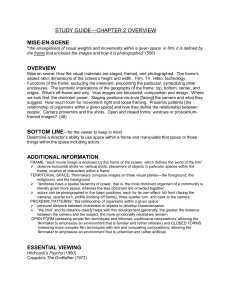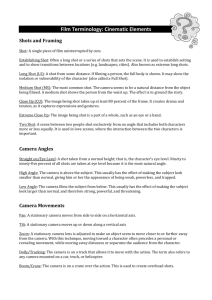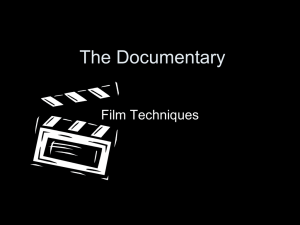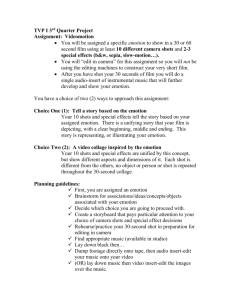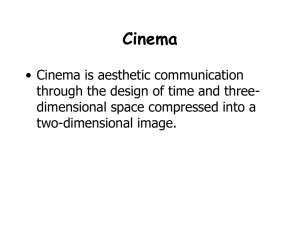The Language of Film
advertisement
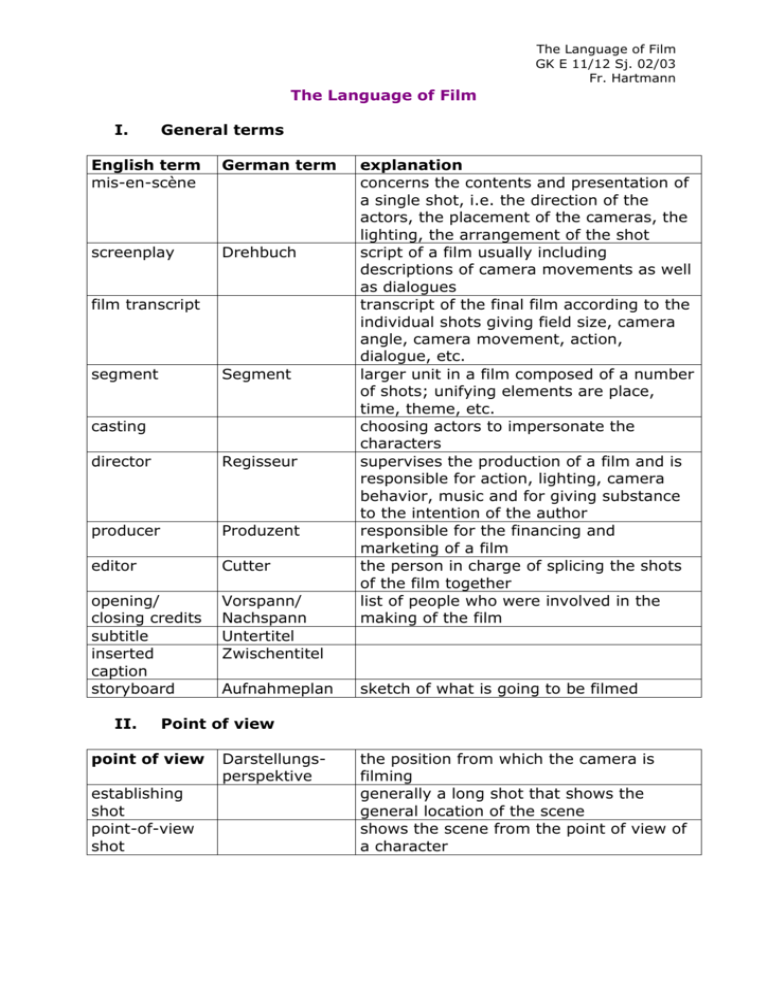
The Language of Film GK E 11/12 Sj. 02/03 Fr. Hartmann The Language of Film I. General terms English term mis-en-scène German term screenplay Drehbuch film transcript segment Segment casting director Regisseur producer Produzent editor Cutter opening/ closing credits subtitle inserted caption storyboard Vorspann/ Nachspann Untertitel Zwischentitel II. Aufnahmeplan explanation concerns the contents and presentation of a single shot, i.e. the direction of the actors, the placement of the cameras, the lighting, the arrangement of the shot script of a film usually including descriptions of camera movements as well as dialogues transcript of the final film according to the individual shots giving field size, camera angle, camera movement, action, dialogue, etc. larger unit in a film composed of a number of shots; unifying elements are place, time, theme, etc. choosing actors to impersonate the characters supervises the production of a film and is responsible for action, lighting, camera behavior, music and for giving substance to the intention of the author responsible for the financing and marketing of a film the person in charge of splicing the shots of the film together list of people who were involved in the making of the film sketch of what is going to be filmed Point of view point of view establishing shot point-of-view shot Darstellungsperspektive the position from which the camera is filming generally a long shot that shows the general location of the scene shows the scene from the point of view of a character The Language of Film GK E 11/12 Sj. 02/03 Fr. Hartmann over-theshoulder-shot the partner in a dialogue is seen from the perspective of a person standing just behind and a little to one side of the other partner so that parts of both are in the frame a shot from the opposite side reverse-angle shot III. Field sizes field sizes Einstellungsgröße, Bildausschnitt extreme long shot long shot Totale full shot Halbnaheinstellung Naheinstellung medium shot/ medium closeup close-up Großaufnahme extreme close- Detailaufnahme up/ detail shot they describe the distance between the camera and the scene a panoramic view of an exterior location photographed from a considerable distance; the actor(s) plus the surroundings can be seen includes at least the full figures of the subjects, usually more, plus environment a shot of a subject that includes the entire body and not much else mixture between a close-up and a full shot, the person is shown down to the waist or hips shot of the subject’s face only, perhaps including the shoulders a shot of a hand, eye, mouth or object in detail The Language of Film GK E 11/12 Sj. 02/03 Fr. Hartmann IV. Camera angle camera angle Kameraperspektive low angle/ Untersicht/ below shot Froschperspektive high angle/ Obersicht/ overhead Vogelperspektive straight-onangle/ eye-level V. Augenhöhe the angle at which a camera is pointed at the subject the subject is filmed from below; objects and people appear to be rather big, powerful, threatening, etc. the camera is placed at an angle above the scene of action; thus objects and people are diminished and appear to be rather insignificant the subject is filmed neither from above nor from below; the camera is at eyelevel with the subject; often used to convey the idea of realism, authenticity and objectivity Camera movement camera movement pan Kamerabewegung movement of the camera during a shot tilt vertikaler Schwenk tracking shot Kamerafahrt zoom Zoom camera pulls back camera moves in horizontaler Schwenk movement from left to right or right to left around the vertical axis (like somebody turning her/his head) movement of the camera upwards or downwards around the horizontal axis (like somebody nodding) the camera moves parallel to the subject from one point to another: in, out or sideways; term is derived from the early film practise of putting the camera on a truck or on a small wagon running on a metal track change of the focal length during a shot ranging from wide angle to telephoto the camera moves back from the subject, gradually revealing the context of the scene opposite of ‘camera pulls back’; the camera moves towards the subject with the context of the scene gradually disappearing The Language of Film GK E 11/12 Sj. 02/03 Fr. Hartmann VI. Montage/Editing montage/ editing shot Filmeinstellung, Aufnahme cut Schnitt scene sequence/ segment parallel action/ cross-cutting flashback flash-forward match cut the process of selecting, cutting and arranging film material in a structured sequence; it determines the narrative structure of a film the basic unit of a film which can be identified as an uninterrupted sequence of action shown continuously; two shots are separated by a cut a cut separates two shots; it is a simple switch from one image to the next a complete unit of film narration, the series of shots taking place in a single location and dealing with a single action basic unit of film construction consisting of one or more scenes that form a natural unit (because of time, actors involved in the shots, setting, theme etc.) intermingling the shots of two or more scenes scene or sequence that is inserted into the present time and deals with the past scenes or shots referring to future time the two shots joined are linked by visual, oral or metaphorical parallelism VII. Punctuation punctuation fade-in Aufblendung fade-out dissolve Abblendung Überblendung refers to the way in which shots are linked the screen is black at the beginning, gradually the image appears brightening to full strength the opposite of fade-in one shot merges slowly into the next: as the first slowly disappears the second becomes distinct VIII. Sound (voice) on (voice) off voice over the speaker (narrator/ character) is shown in the picture the speaker (narrator/ character) is not shown in the picture the voice of the narrator speaking while other sounds including voices of the characters continue The Language of Film GK E 11/12 Sj. 02/03 Fr. Hartmann

